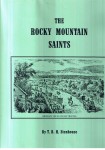The Rocky Mountain Saints by T.B.H. Stenhouse (1873 (photomechanical reproduction); Utah Lighthouse Ministry)
Mr. Stenhouse’s historic depiction of the rise of the Church of Jesus Christ of the Latter-day Saints ( the Mormons) was originally published in 1872. He and his wife were once ardent followers of the faith, to include T.B.H. taking a plural wife over Fanny’s somewhat tepid objection to sharing her husband with another woman.
However, a series of misfortunes befell T.B.H’s career in the newspaper industry. He wrote for The Mormon in New York City and, after migrating to Utah, founded the Telegraph. On Brigham Young’s command (and as apparently ordained by God) Stenhouse moved his fledgling newspaper from Ogden to Salt Lake City, where it promptly failed.
Seeing little evidence of the divine revealed by the misunderstanding between God and Mr. Young, T.B.H. divorced his plural wife and asked to be excommunicated. He’d lost faith in the infallibility of the Mormon priesthood and seriously doubted that the origins of the religion, as related by Joseph Smith, were divinely inspired. Soon thereafter,Fanny followed her husband into apostasy.
This background (none of which is included in the book) could serve to render The Rocky Mountain Saints a heated, unfair diatribe against Mormonism. But it’s a credit to Stenhouse’s journalist ethic that he refrained from invoking vindictive prose to attack his former spiritual leader: Throughout the book’s 762 pages, Stenhouse maintains proper authorial distance from his subject matter.
Initially, reading The Rocky Mountain Saints requires adjusting to the archaic language of the times. But after a few chapters, Stenhouse’s writing style overcomes this initial difficulty.
In the end, the volume is an invaluable study into the beginnings of the Mormon church through the eyes of folks who lived and breathed the fire and brimstone of President Brigham Young’s sermons.
Despite Fanny’s own apostasy (her book, A Lady’s Life Among the Mormons created its own scandal in the late 1800s) and T.B.H’s decision to disavow his faith, this book is embedded with the sort of journalistic fairness rarely found in today’s print or electronic media. 4 stars out of 5.




A well stated review. It is rare indeed to find such a balanced and detailed history of the early Mormon church, whether from that time period or today. Having an interest in Mormonism and a close relationship thereto, I have read similar histories, both old and modern. Many of today’s authors continuously assert that we cannot truly know the thoughts, feelings, intents, and behavior of those who lived so long ago. Setting aside that these same scholars suppose to understand such things regarding characters of ancient scripture, I believe that this text serves as a testament against such claims as it is written by one closely associated with the high ranking leaders of the time and whose talent and experience as a journalist leave little bias towards the subject, even given his falling away. This is an enlightening volume that is invaluable for those seeking illumination on the truth of Mormon history.
Thanks for reading the review and leaving a comment!